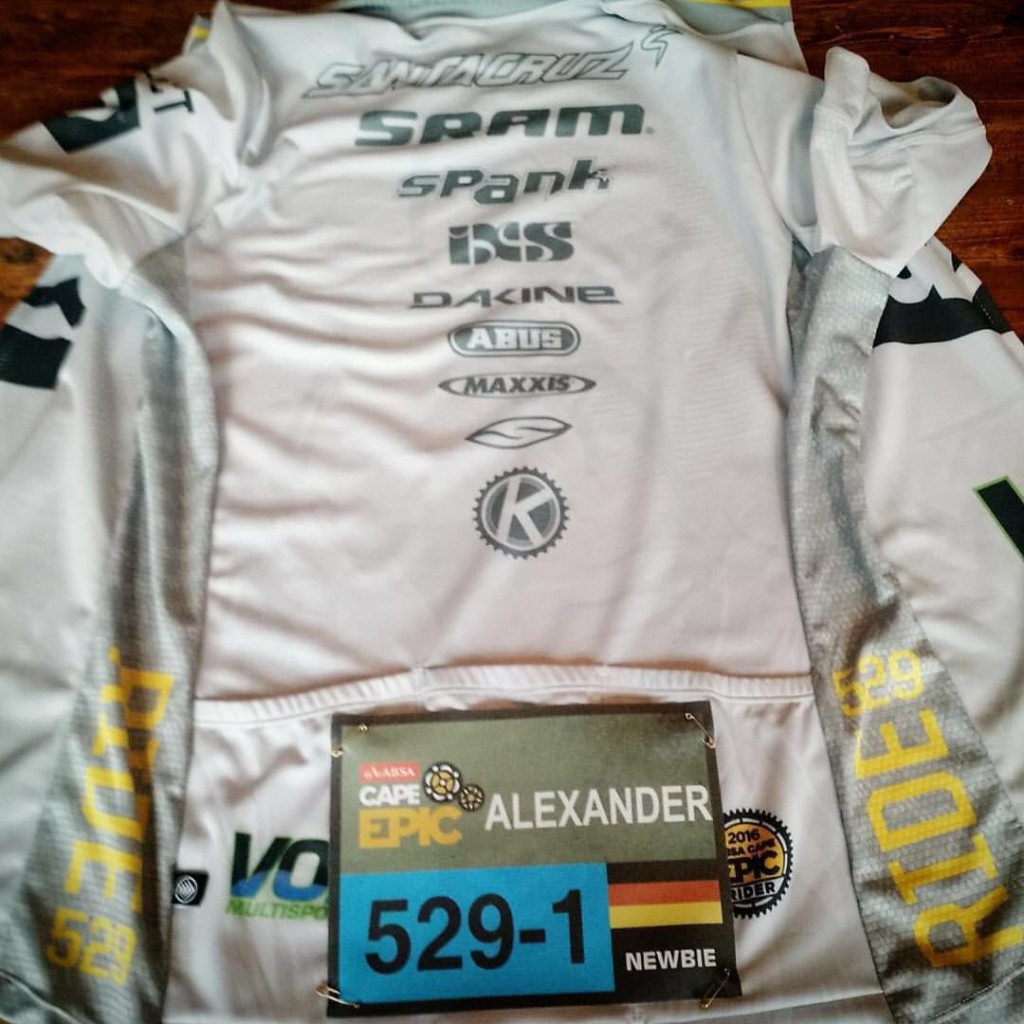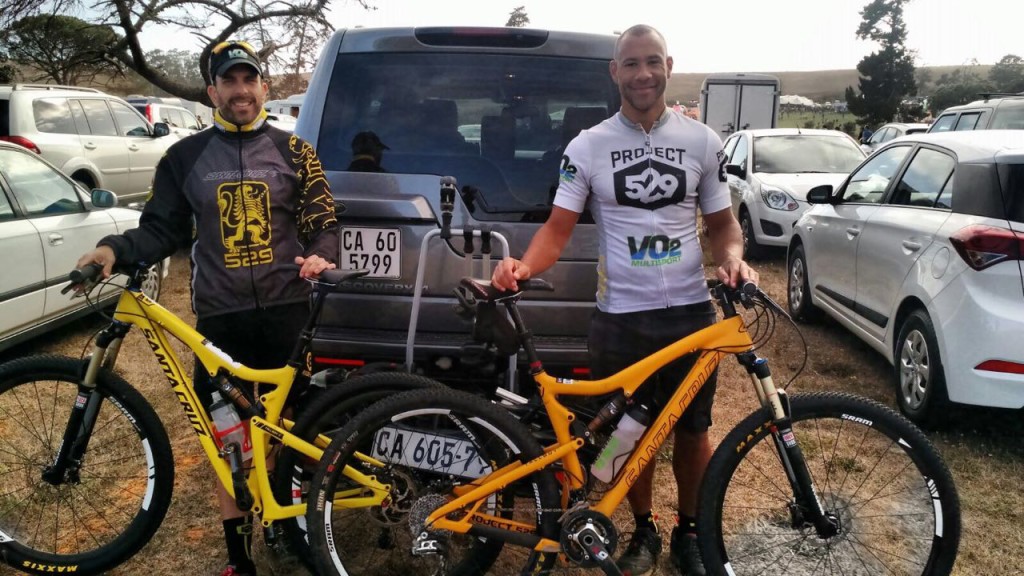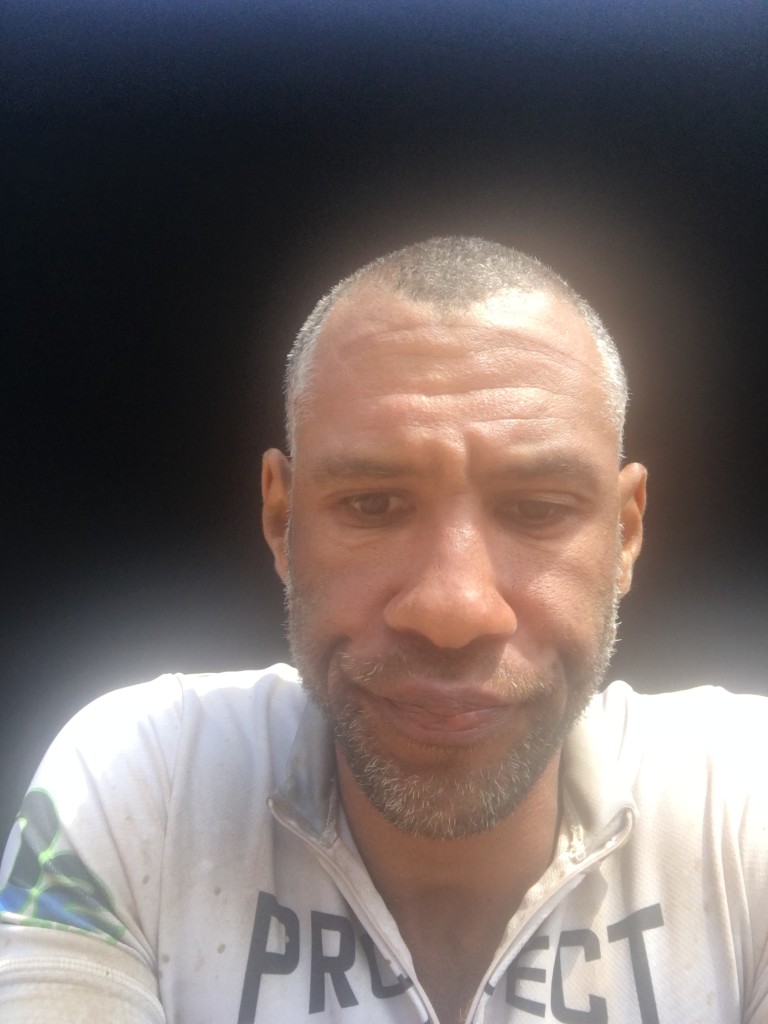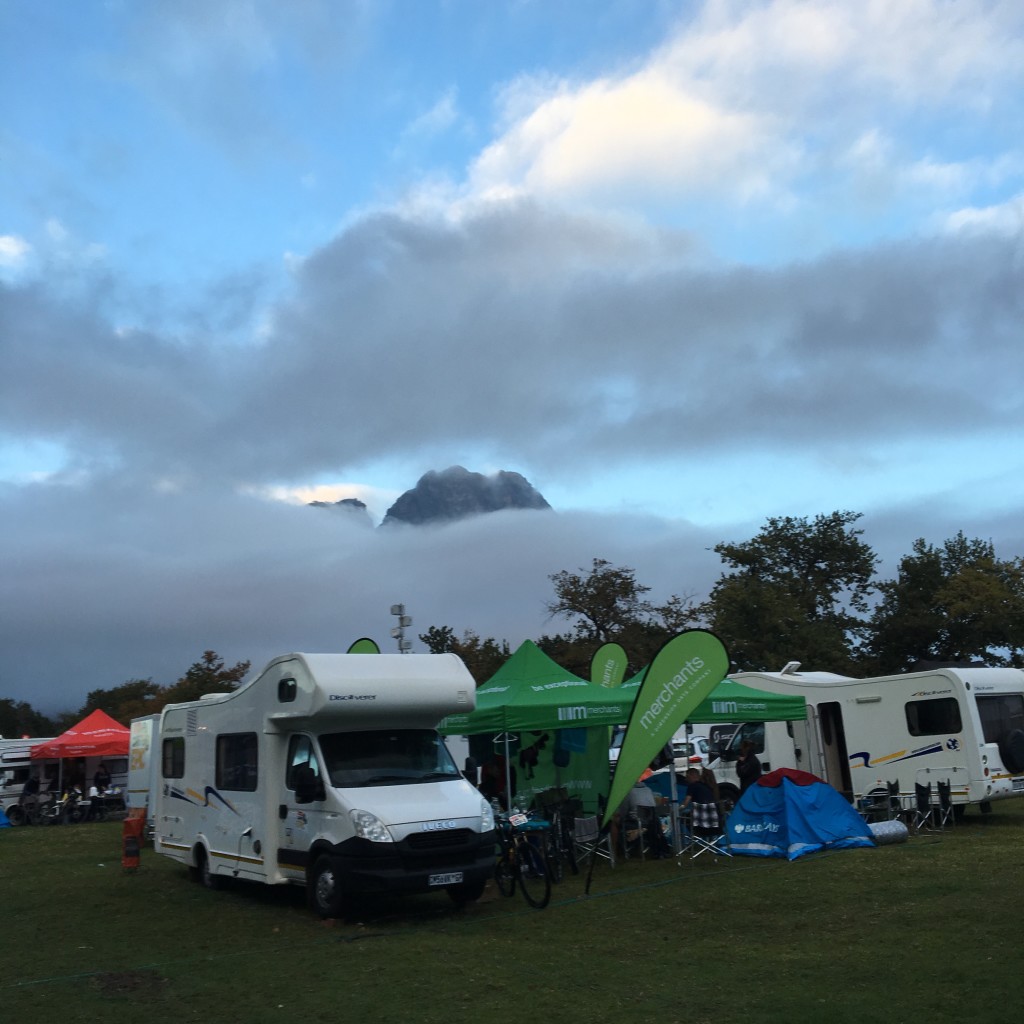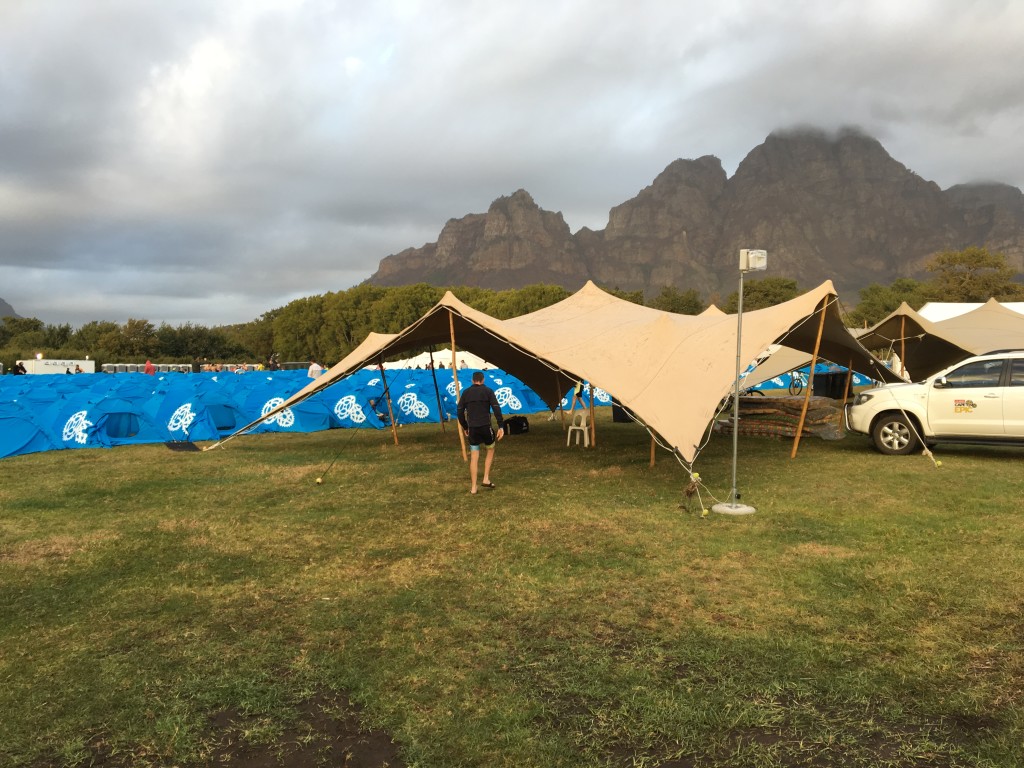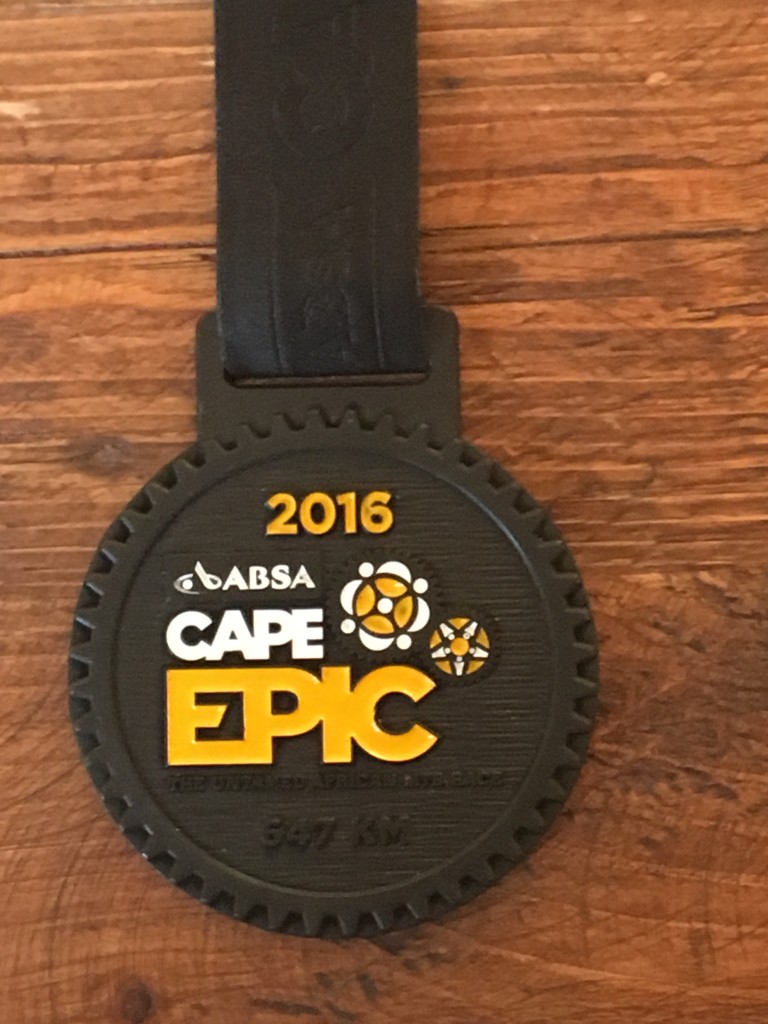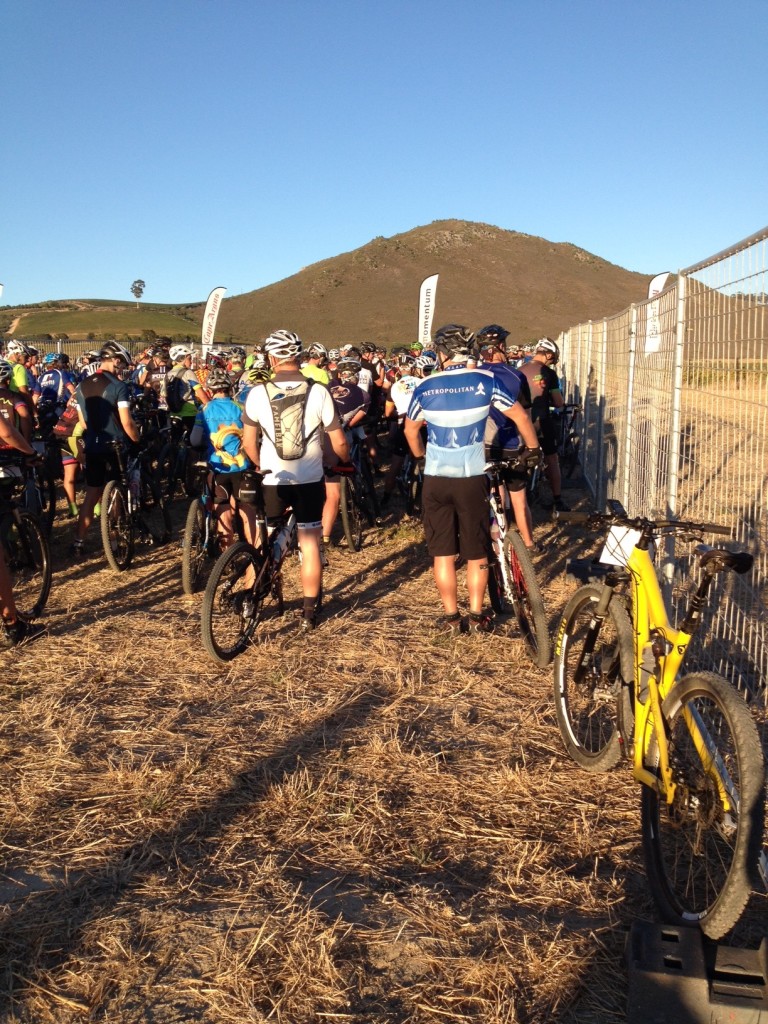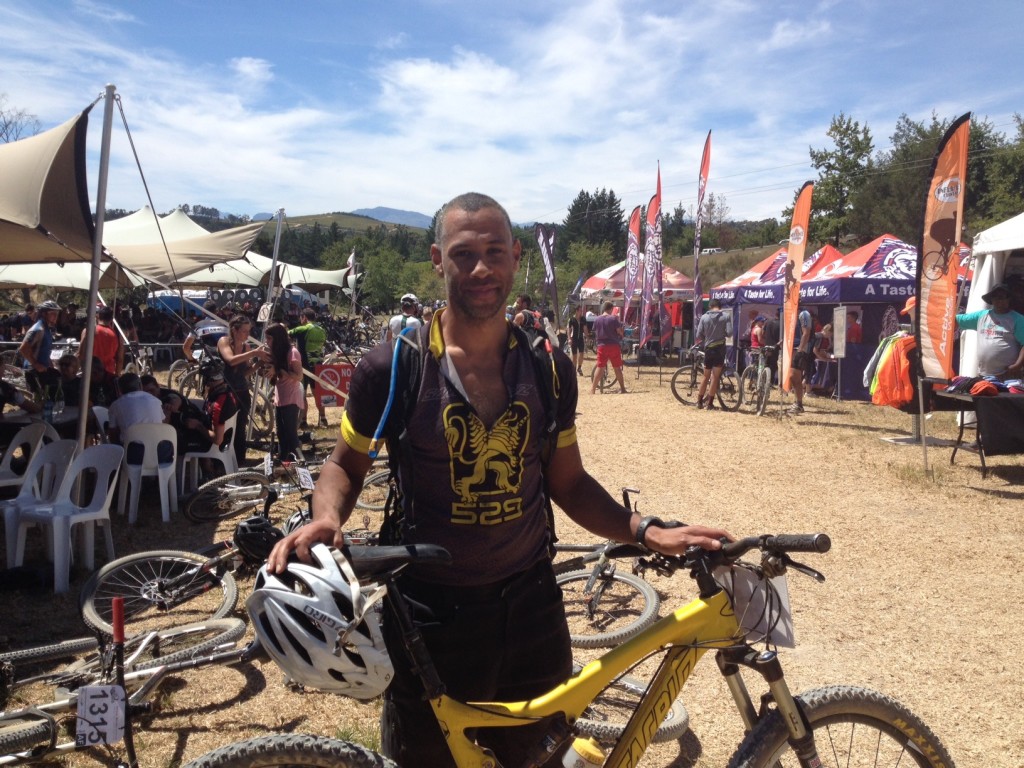What is this Cape Epic thing, anyway?
In short, it’s a multi-day mountain bike race. Quoting freely from the relevant Wikipedia article, “The Absa Cape Epic is an annual mountain bike stage race held in the Western Cape, South Africa. It has been accredited as hors categorie (beyond categorisation) by the Union Cycliste Internationale. Among other events in world cycling which enjoy this status are the Tour de France, Giro d’Italia and Vuelta a España. […] The Absa Cape Epic was described by Bart Brentjens, 1996 Olympic gold medallist in mountain biking and a former Absa Cape Epic winner, as the “Tour de France of mountain biking””
So, yeah, it’s a hard race.
Sounds un-fun. Why did you do it?
It started, as have so many of my questionable endeavors over the past 20 years, with a suggestion from Brandon. In this case, it was him saying “Hey, while you’re living in South Africa, we should do the Cape Epic”, in early 2015. At this point, my definition of a long mountain-bike ride was anything over 40km, so my reply was pretty much unprintable, and there the matter rested.
However, since the Prologue stage of the 2015 Epic went pretty much right by my front door, and there had been a bunch of hoopla on TV about it, I decided to go watch the Prologue and see what sort of insane people signed up for something like the Epic. As I watched the non-pro riders go by, and saw that they didn’t all look like aliens from Planet Bicycle, I started to think “…. wait a minute, these look like the type of riders I see out every day …” … and thus were the seeds of madness planted.
Once I started actually considering it, I talked to Coach Ben to see how long he thought it’d take to get ready, secretly hoping he’d tell me it would take me 5 years, 2 million hours of training, and losing 50% of my body weight. Unfortunately, he figured I could get ready in a year, and so I couldn’t use that as an escape. Next came one of those awkward conversation with our significant others, the ones where you start off with “Hey, honey, so I’ve been thinking about …”, in the hope that the casual tone will lull them into saying yes without really paying attention. Thankfully, being the awesome, super-understanding wives they are, they gave Brandon and me permission to undertake this latest bit of shared insanity.
After that, the last hurdle was actually getting an entry, because the Epic sells out pretty much instantaneously every year. and we were lucky enough to get one of the 100 early-bird entries that sold out in 9 seconds. (Suspiciously, the 100 early-bird entries for next year’s race also sold out in 9 seconds, which makes me think their online system is only capable of handling 11 transactions per second.) Once all that was out of the way, it was time to get down to the business of actually doing the necessary training.
Training
I trained via a combination of rides outside and indoors on a Wahoo Kickr. In general, my training sessions during the week started between 4-4:30am and were done by 6 am; weekend rides started between 4-5am and were done by 10:30am at the latest.
Training stats, from 4/1/2015 – 3/12/2016:
– 338 hours total (both on the trainer and riding outside)
– 120 trainer sessions
– 58 rides outside
– Total distance ridden outside: 3668km (2292 miles)
– Total distance climbed: 83,270m (~275,000 feet)
– Average distance per ride: 63km (~40 miles)
– Average climbing per ride: 1435m (~4700 feet)
I was primarily worried about the climbing, and so I made sure that I climbed as much as possible during my long weekend rides, trying to get in at least 1800m (~6000 feet) of climbing each time. Most of my rides were around Table Mountain, with a typical ride looking like this.
The above numbers also include the 3 races I did as preparation: the Berg and Bush 3-day stage race (stage 1, stage 2, stage 3); the Attakwas single-day race; and the DuToit Tankwa Trek 3-day stage race (stage 1, stage 2, stage 3).
When I started the Epic, I weighed about 85kg (~187 lbs), and had an FTP of 300W (measured Dec 4th, via a 60-minute test). On the morning after the Epic was over, I weighed 80kg.
Logistics
Per the advice of my friend Max, we made life as easy for ourselves as possible: we rented a motor home so we didn’t have to sleep in a tent, we got a personal massage therapist who also drove the motor home from stage to stage, and we arranged for the good folks at Trail and Tar to sort out our bikes after every stage. It wasn’t cheap, but it contributed immeasurably to our peace of mind and ability to recover after each stage to not have to worry about any of that sort of logistical stuff. After each stage, we just dropped off our bikes with the mechanics, took a shower, got a massage, went for dinner, and were generally in bed by 9:30pm.
The Race

By using the super-sophisticated tactic of simply asking for it, Brandon also managed to get us the ideal team number.
The official course description for the 2016 Epic claimed the race would cover 654km (408 miles), with 15000 meters (49500 feet) of climbing. Per my bike computer, we did 661km (413 miles), and climbed 15855 meters (52300 feet), so overall the actual route came pretty close to the official description.
It was pretty windy out at Meerendal during the Prologue, which was Brandon’s first introduction to the crazy Western Cape wind. He wasn’t enthusiastic about the conditions, but it was a very short stage, so at least it was over quickly. (Total stage time: 1h 42min)
Stage 1: A long stage, but none of the terrain was particularly demanding (eg loose or sandy), so I got through it without too much trouble. It was very hot, though, around 32/33C (+90F). (Total stage time: 8h 9min)
Stage 2: This was the 100th stage in the overall history of the Epic, so there was a bunch of hoopla about it during the previous evening’s stage briefing. However, I found it pretty uninspiring. There was a big climb very early on which was basically just everybody pushing their bikes up the entire way because people kept stopping and getting off at even the slightest hint of a rock bigger than a pebble. Then, on the way back, we went down the same way we came up and again had to stop a bunch because once again people couldn’t ride over (small!) rocks, even downhill. Overall that made for a pretty long day, and all the hike-a-bike totally trashed my legs. It was also another very hot day, so I felt fairly tired after this stage. (Total stage time: 8h 8min)
Stage 3: I knew I was in trouble 10 minutes after we’d started pedaling – my legs were just not having it, and even the smallest climb required enormous effort. Brandon, meanwhile, was feeling pretty good, so I just hung on to his rear wheel for dear life, and made it to the first water point. That was when life really started to suck, because what had been euphemistically described during the stage briefing as “a little bit of sand” turned out to be 30km of sand between water point 1 and water point 2. Riding through sand is the most soul-sapping experience imaginable, more so when you’re already feeling weak, so by the time we got to the second water point I just wanted to lie down and cry. And we were still only half-way through the stage …
Next came the climb on the road up Bain’s Kloof, which was beautiful scenery but for me was the deepest I’ve ever been in the pain cave. At one point, I had to get off and just drape myself over my top tube for a few minutes with steam coming out of my ears while trying to recover some semblance of composure. Brandon was the ideal team-mate through this, patiently waiting for me and encouraging me along. Thankfully, I somehow recovered a bit once we hit the single-track section of the stage, even though it included a fair bit more climbing, and we managed to nurse it home 35 minutes before the stage cut-off time. This was another very hot stage, so hot that the organizers set up 3(!) extra water points. I was totally shattered after this stage – I barely had the energy to go shower, and was too tired to really eat dinner. (Total stage time: 8h 41min)
Given how the previous day had gone, and the fact that I still felt pretty wrecked, I started the stage with a fair amount of trepidation. Thankfully, while I was still in bad shape, it wasn’t nearly as bad as the day before. Once again, Brandon was feeling good and pulled us through the stage, and we made it with over an hour to spare before the cut-off. (Total stage time: 5h 54 min)
Stage 5: This was billed as the “Queen Stage” of the race, because it had the most climbing, and was the one Brandon and I had been most worried about. I realized fairly early on that I was actually feeling pretty good, but then it became clear that it was Brandon’s turn to meet The Man with the Hammer. I matched his speed, walked with him when necessary, and he pushed himself super-hard, but by the time we got to water point 3, it was clear that he was in serious trouble. The medics came over to look at him, poked him a bit, asked him a few questions, and then diagnosed him with extreme dehydration and in urgent need of an IV. And, given that we still had 30km to ride, including a big climb, and only 2 hours in which to do it, it was clear that he wasn’t going to finish the stage. So I was given a choice: stay with him, or try to finish the stage in time myself. I wanted to stay, he told me to go, so we cried a bit, hugged it out, and then I rode off. I ended up making it with 15 minutes to spare, but it was an awful feeling to cross that finish line without him. (Total stage time: 8h 16 min)
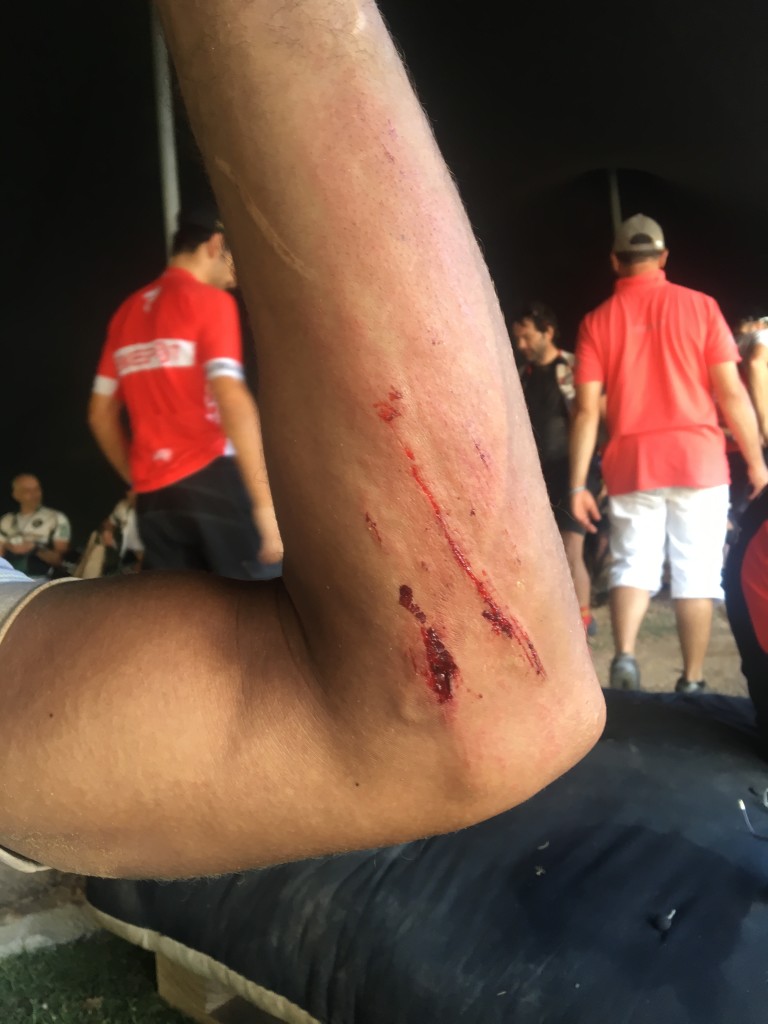
A little souvenir I picked up on the designated technical section of Stage 5, trying to make it home before the cut-off.
By the time I got back to the camper, he was back as well, having received a couple of IV bags, but still feeling like crap. We talked a little bit, but it was clear he was still very much running on fumes, and he fell asleep around 5pm.
Judging by the fact that he’d shown no signs of waking up anytime soon while I was getting ready in the morning, I figured Brandon was still out of commission, and lined up to ride the stage on my own. It was a bummer to ride alone, because it was the most fun stage so far – lots of flowing single track, both climbing and descending. I felt pretty good, but given the previous couple of days, didn’t want to push very hard, and so I just focused on enjoying it. (Total stage time: 5h 38min)
When I got back, I found out that Brandon had slept till 9am ie he’d slept 17 hours, but he was looking and feeling a lot better. Based on a discussion Brandon had with the medics the previous day, we were under the impression that we’d be able to ride the last stage together. Unfortunately, that turned out to be against the rules and, despite lodging all sorts of appeals (including getting the medics to talk to the race director), he wasn’t cleared to ride the last stage. That was of course hugely disappointing, and took the wind out of my sails for the last day.
Stage 7: At this point, I was very much in a “Let’s just get this over with” mindset, so it didn’t help my mood that 2-3 hours of this stage involved grinding along flat dirt roads, into a head wind, with nothing pretty or interesting to look at. I tried riding in a pack, but couldn’t find one that had the right speed – they were either going too fast or too slow, so mostly I ended up just riding by myself. By the time I crossed the timing mat for the last time, I was very much ready to be done. Christina, Helena, Xander and Brandon met me at the finish line, I choked back some tears, and suddenly it was all over. (Total stage time: 5h 22 min)
Overall, about 630 teams started the race, and 483 teams finished. Per my final stats, it took me 51 hours and 52 minutes to finish, which put me in 100th place out of the 134 individual finishers (ie people whose partner had also withdrawn). Not exactly a spectacular result, but given that my primary goal was to finish, I’ll take it.
General musings
Logistically, the Epic is extremely impressive: registration was very efficient, the port-a-potties and showers were always clean, the food was decent and plentiful, each stage started on time, the courses were well-marked, the water points had lots of choices of food and drink etc. Making that happen flawlessly, with over 1200 riders, over 8 days, in 3 different locations, takes a lot of work. About the only thing I think they could have done better was to have cold water and ice at the water points, rather than the sort-of-cool water that was available – it’s not very much fun to drink lukewarm water when you’re already overheating.
The stage routes: meh. Although this year’s race was billed as having the most singletrack ever, we still spent a lot of time riding through vineyards and on dirt roads.
Overall, I feel like I was well-prepared for the race. All the climbing I did on my training rides certainly paid off – I wasn’t intimidated by the climbing required and was generally one of the stronger climbers in the groups we rode with. Brandon and I were also among the better descenders and technical riders – we spent lots of time fuming about people ahead of us slowly picking their way through anything that had rocks bigger than a fist. The bits of riding that actually hurt me the most (relative to what should have been required) were the flat grinds along dirt roads – I didn’t do very much flat riding during training and so didn’t have the muscle memory to efficiently cruise along those sections. Luckily, that sort of riding is Brandon’s forte, so I generally tucked in behind him and let him pull us through those parts.
Would I do it again? Probably not. While it was awesome to hang out with Brandon, I just didn’t enjoy it enough relative to what was required, both in terms of training time and the attendant sacrifices, as well as financial cost. It also felt like the organizers went out of their way each day to throw in a little unnecessary pain, to make sure they maintained the Epic’s reputation as the hardest MTB stage race in the world. For example, at the last water point on Stage 6, we were told that the stage was actually 3km longer than we’d been told the night before, and then it turned out that those extra 3km consisted of some ridiculously rocky singletrack that just took all the joy out of what had been a great stage. My running joke was that the hashtag for the Epic shouldn’t be #8DaysOfCourage, but rather #ItsAlwaysOneMoreFuckingThing. And, last but not least, an 8-day race is just really long.
I couldn’t have done this without a ton of support and help, so I owe a huge debt to all the folks who helped make this happen:
- Christina and the kids, for putting up with my long weekend rides and me being tired a lot, and being super-supportive and attentive during the race, including calling the Epic race office when they thought we were stuck in a field [which we weren’t, but it looked that way because our tracker was malfunctioning :-)]
- Brandon, for suggesting we do this in the first place, and giving us yet another set of awesome memories
- Ben, for getting me ready from half a world away
- Thomas, Victor, Jessica, Janaina and my mum for all the supportive messages throughout the race
- Christian, for designing our riding kit
- The 529 crew for introducing me and Brandon to mountain biking, and all the support before and during the race
- Iulian, Walter, and Danian for all the training rides and races, and putting up with me whinging about having to stay in a particular heart-rate zone
- Max and Dirk, for giving me solid advice about logistics around the race
- Grant and the crew at Trail and Tar for taking such good care of our bikes that we didn’t have single mechanical issue throughout the race. (We both rode Santa Cruz Tallboy Carbons, with SRAM drivetrains and wheels, and Maxxis Ikon tires)
- Kurt for being an awesome massage therapist and generally a cool guy to hang out with
What’s next? Well, I hear the Swiss Epic has a lot of singletrack, goes through incredible scenery, is shorter, and isn’t as hot …
